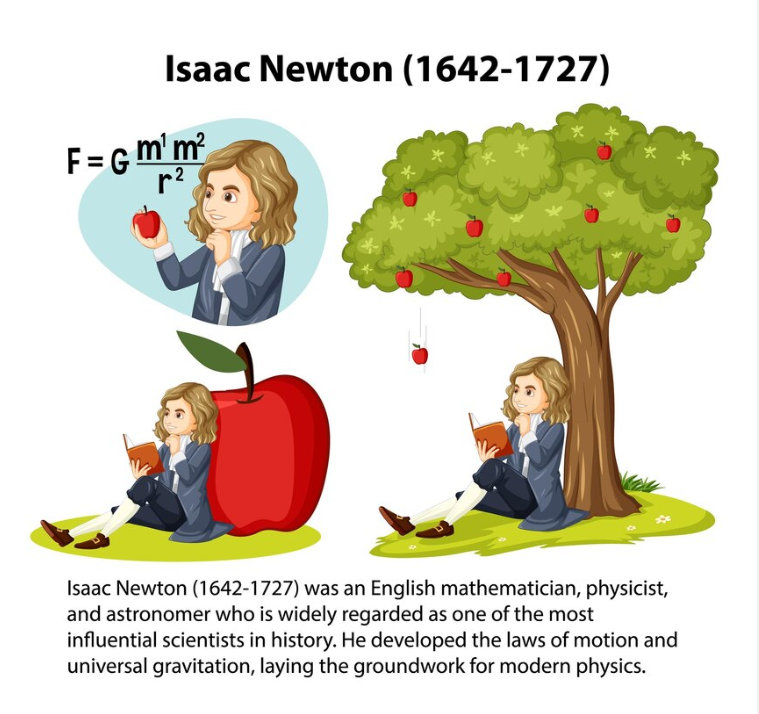2.4 Newton’s First Law of Motion: The Law of Inertia
What is Newton’s First Law? 🐘
Newton’s First Law, also known as the Law of Inertia, states:
“An object will remain at rest, or continue to move at a constant velocity in a straight line, unless acted upon by an unbalanced external force.”
In essence, objects tend to resist changes to their state of motion. This law underscores the concept of inertia, which describes the tendency of objects to maintain their current state of motion. It is often considered a special case of Newton’s Second Law when the net external force acting on an object is zero.
Key Concepts: Inertia, Frames of Reference, and Equilibrium
1. Frame of Reference
A frame of reference is a coordinate system used to describe motion. An inertial frame of reference moves with constant velocity, meaning objects within it follow Newton’s First Law.
2. Inertial Mass
Inertial mass measures an object’s resistance to changes in motion. The greater the mass, the more it resists changes in motion. For example, it takes much more force to move an elephant than an ant due to the elephant’s larger inertial mass.
Understanding Equilibrium
An object is in equilibrium when the vector sum of all forces acting on it equals zero. This can occur when:
- The object is at rest.
- The object moves with a constant velocity.
Example Problem #1
Scenario: A student sits at rest in a classroom. Another student pushes the desk, causing it to move across the room. The teacher then pushes the desk in the opposite direction.
Questions & Solutions:
- What is the external force acting on the student and desk?
The external forces are the pushes applied by the student and teacher. - How does the student’s inertia affect their motion?
Inertia resists any change in motion. Initially, the student and desk remain at rest. When pushed, they continue to move unless acted upon by another force. - If the teacher pushes with a greater force, what will happen?
The desk and student will accelerate in the direction of the greater force. - How does mass affect motion?
A greater mass means more resistance to changes in motion (higher inertia), so more force is required to accelerate heavier objects.
Designing Experiments to Explore Inertia
Example Problem #2: Designing an Experiment
Goal: Determine the relationship between net force, inertial mass, and acceleration of a small wooden block.
Step-by-Step Procedure:
Identify Variables
- Independent Variable: Net force applied to the object
- Dependent Variables: Inertial mass and acceleration of the object
Experimental Setup
- Force Application Device: Spring scale or force sensor
- Mass Measurement: Balance scale
- Acceleration Measurement: Timer or photogate
Procedure
- Measure the inertial mass of the object.
- Apply different forces using the spring scale or force sensor.
- Measure the object’s acceleration for each force applied.
- Record all data.
Analysis
- Plot force, mass, and acceleration data on a graph.
- Verify that the relationship follows the equation .
Gravitational Mass vs. Inertial Mass 🐁
Key Concept:
Gravitational Mass is determined by the gravitational force experienced by an object in a gravitational field, while Inertial Mass measures an object’s resistance to changes in motion.
Equations:
- Gravitational Mass: Found by comparing an object’s gravitational force to a known reference mass.
- Inertial Mass: Measured by applying a known force and using the equation .
Important Note: Experimental evidence shows that gravitational mass and inertial mass are equivalent.
Designing Experiments for Gravitational and Inertial Mass
Example Problem: Measuring the Mass of a Golf Ball
Task: Design a plan to measure and compare the gravitational mass and inertial mass of a golf ball.
Part A: Explain Differences
- Gravitational Mass: Measure of gravitational attraction.
- Inertial Mass: Measure of resistance to motion.
Part B: Measuring Gravitational Mass
- Materials: Balance scale
- Procedure: Compare gravitational force of the golf ball to a known mass.
Part C: Measuring Inertial Mass
- Materials: Force sensor and acceleration measuring device (timer or photogate)
- Procedure: Apply known forces to the golf ball and measure acceleration.
Part D: Data Comparison
- Compare measured values to check if gravitational and inertial mass are equal.
Part E: Addressing Errors
- Discuss potential errors and how to minimize them (e.g., friction, air resistance).
Key Takeaways
- Newton’s First Law emphasizes that objects resist changes in motion.
- Inertia is directly tied to mass; heavier objects have more inertia.
- Equilibrium occurs when net forces equal zero, resulting in no acceleration.
- Gravitational and Inertial Masses are experimentally shown to be equivalent.








